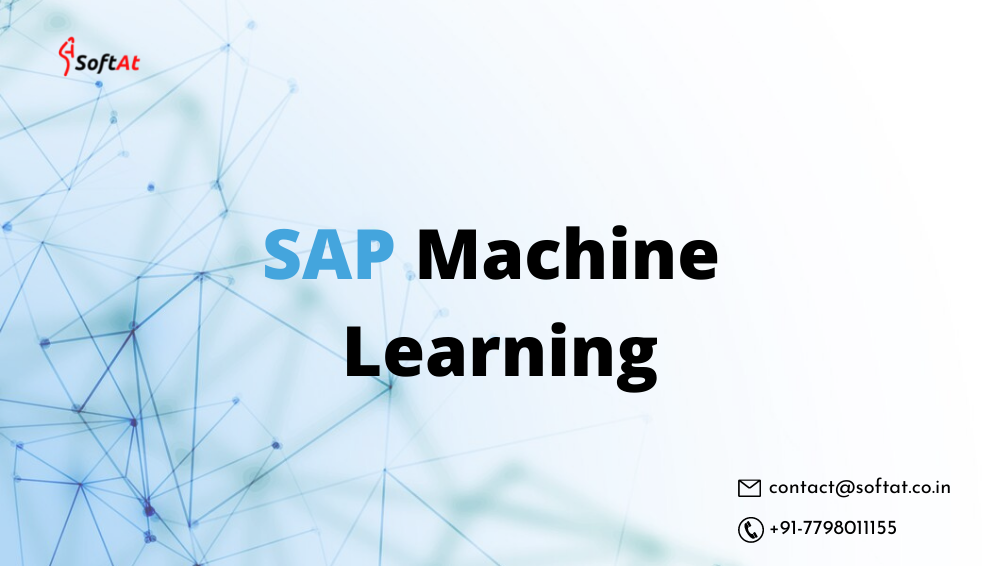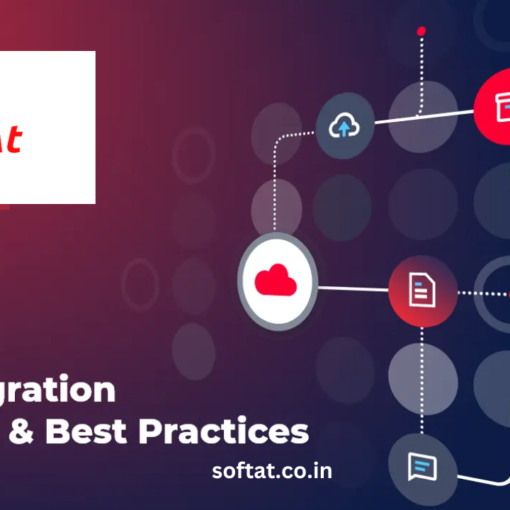What is SAP Machine Learning?
SAP Machine Learning is a subset of SAP Artificial Intelligence (AI). Instead of being expressly programmed to do so, it focuses on educating computers to learn from data and improve with experience. Algorithms are trained in machine learning to detect patterns and correlations in big data sets and to make the best decisions and predictions based on such findings. Machine learning applications grow with use, and the more data they have, the more accurate they become. Machine learning is used in a variety of places, including our homes, shopping carts, entertainment media, and healthcare.
Fundamentally, machine learning models use their incoming data, actions, and experience to iteratively improve performance and accuracy without the need for human involvement. Numerous specific machine learning algorithms can be used for everything from trend analysis to recommendations.
Many well-known and commonly utilized services benefit from the usage of machine learning. Machine learning is quietly pervading many facets of our daily lives, whether it’s used in stock market analysis, targeted advertising, tailored movie or book suggestions, or natural language processing(NLP) in digital personal assistants.
Machine learning is being used internally by businesses to improve security, automate activities, and undertake trend research. Forward-looking predictions, for which machine learning algorithms are designed, are an excellent approach to supplement traditional strategic planning. Given the increasingly huge data sets that companies host in SAP systems, incorporating machine learning into SAP data analysis was a natural decision. Machine learning is now heavily used in several SAP modules to improve data analytics, predictive analytics, and decision making.
SAP HANA Cloud
SAP HANA Cloud is a cloud-native database-as-a-service (DBaaS). It enables SAP users to create applications based on data aggregated from a variety of sources. Data from other SAP modules and outside sources such as Amazon Athena, Google BigQuery, and Spark SQL can be accessed using the HANA cloud.
Intelligent Automation and Process Optimization:
SAP machine learning enables intelligent automation by automating repetitive and time-consuming tasks. ML algorithms can learn from historical data and perform tasks such as data entry, invoice processing, and document classification. This frees up valuable human resources and allows employees to focus on higher-value activities. By automating processes, organizations can enhance operational efficiency, reduce errors, and improve overall productivity.
Predictive Analytics and Forecasting:
With SAP machine learning, businesses can leverage predictive analytics to make accurate forecasts and projections. ML algorithms analyze historical data, identify patterns, and generate insights that help organizations anticipate customer behavior, demand trends, and market dynamics. This enables businesses to make informed decisions, optimize inventory management, and deliver personalized customer experiences.
Customer Experience and Personalization:
SAP machine learning enables organizations to gain a deeper understanding of their customers. ML algorithms analyze customer data, including preferences, purchase history, and behavior, to provide personalized recommendations and targeted marketing campaigns. This enhances the customer experience, increases customer satisfaction, and drives customer loyalty.
Fraud Detection and Risk Management:
SAP machine learning plays a crucial role in fraud detection and risk management. ML algorithms analyze transactional data, identify anomalies, and flag suspicious activities in real-time. This helps organizations prevent fraudulent activities, safeguard sensitive data, and ensure compliance with regulatory requirements. By proactively detecting and mitigating risks, organizations can protect their reputation and financial well-being.
Intelligent Insights and Decision-Making:
SAP machine learning provides organizations with intelligent insights to support data-driven decision-making. ML algorithms analyze vast amounts of data, identify trends, and generate actionable insights. These insights empower business leaders to make informed decisions, optimize processes, and drive innovation. SAP’s ML capabilities enable organizations to transform raw data into valuable knowledge, unlocking new opportunities and competitive advantages.
Continuous Learning and Improvement:
One of the key advantages of SAP machine learning is its ability to continuously learn and improve over time. ML algorithms can adapt to changing business conditions, incorporate new data, and refine their models. This iterative learning process enables organizations to enhance the accuracy and effectiveness of their predictive models, leading to better decision-making and improved outcomes.
Automated Predictive Library
APL is a set of functions that allow users to create predictive data mining models based on company data to answer business issues. In APL, there are five predictive algorithms:
- Input data is assigned to specified categories or labels using classification algorithms.
- Regression algorithms use data to predict future values. For general business forecasting, regression analysis is useful.
- Data is divided into groups using clustering algorithms, such as classification algorithms. The clustering model, on the other hand, does not use predefined groupings and instead categorizes data based on similar qualities.
- Time series analysis algorithms examine the relationship between data points collected over time and forecast future values based on the results. Stock price prediction is a typical example of time series analysis.
- Recommendation algorithms use past data to provide recommendations for future actions. Targeted advertising is a widely known example of a recommendation model.
SAP Analytics Cloud
SAP Analytics Cloud is a comprehensive analytics platform that includes business information, predictive analysis, planning, and forecasting. It uses machine learning to assist users in mining data across the enterprise for trends and patterns that can be used to make informed, forward-looking business choices.
High-performance analytics have limited value if their data cannot be translated into easily understandable business information. For analytics reporting, SAP Analytics Cloud features robust, customized dashboards. The digital boardroom for the C-suite is included in SAP Analytics Cloud, and it displays historical data and future predictions to aid company-wide strategic planning.
SAP Intelligent Robotic Process Automation
Automation is an important part of running a successful business. Companies can use SAP Intelligent Robotic Process Automation (RPA) to construct bots that handle repetitive manual activities, allowing people to focus on more important duties.
SAP Intelligent RPA can be found in every department of the firm, from cybersecurity and operations to research and development, HR, and accounting. SAP RPA features machine learning capabilities that allow bots to iteratively improve their decision-making and performance by learning from their prior actions and data.
SAP Conversational AI
Through intelligent chatbots, SAP is using artificial intelligence and machine learning to improve customer experience and staff engagement. Conversational AI chatbots are gaining popularity due to their ease of development and use. The chatbot development engine is low-code, relying on natural language processing and logic modules to launch bots quickly.
Companies can utilize Conversational AI to help automate regular employee actions, such as expense reimbursements and vacation requests, in the human resources department. Additionally, Conversational AI can help employees and management communicate more effectively by offering business updates and responding to employee input.
SAP Machine Learning Use Cases
Capabilities of Machine Learning
Key Performance Indicators (KPIs) are frequently used in organizations to make decisions. As a result, machine learning has its own set of KPIs or features. They are used as input in the calculation. The model may learn complex relationships and interactions with their help and provide a specific result.
It is possible to determine the degree of similarity between data sets and assign them to a group. We distinguish here between pre-defined groupings (classification) and pattern recognition (clustering). Regression is the process of using an information base to find a target value.
Innovative ideas for application
Machine learning’s broad range of capabilities opens up several opportunities in a company’s most diversified departments. Only a small portion of these options are depicted in the mind map. The next sections will provide you a quick overview of the many application scenarios for the project ideas.
- Cash flow forecasts
- Fraud detection for customers and suppliers
- Employee fluctuation
- Customer segmentation
- Predictive maintenance
The accuracy of forecasting available capital can be raised by a factor of many times when applying Machine learning cash flow forecasting. Forecasts can be made for a variety of time periods and levels (product or global). The best part is that, in most cases, the vast business data you’ll need to get started is already in your databases.
The false positive rate is another quality requirement when employing machine learning models, in addition to the reliable detection of true fraud. This reflects the percentage of suspicious instances that were not confirmed as fraud after a comprehensive investigation and were thus labeled wrongly. To accomplish this, fine-tuning ML models is frequently required, balancing the risk of undiscovered fraud against the cost of manual validation.
Machine learning can also be used to better assess employee fluctuation. Early warning indicators can be identified, which can assist you in making better personnel decisions and estimating the demand for recruitment.
Learn more about your clients and apply Machine Learning for customer segmentation. It is feasible to include additional, increasingly complicated criteria, such as those relating to the intensity and type of client contact, in addition to basic factors such as industry, firm size, and geography. The segmentation allows for a more targeted approach and new methods to personalize products.
Machine Learning is very useful in the production process. Machine data, data from the production management system, and data collected on the shop floor can all be leveraged to save money. Machine data can be evaluated (predictive maintenance) in the maintenance field to optimise maintenance cycles or warn of future breakdowns. Appropriate service can save production costs by preventing catastrophic damage and extensive downtime.
Conclusion:
SAP machine learning is revolutionizing the way businesses operate and make decisions. By harnessing the power of advanced algorithms and data analytics, organizations can automate processes, gain predictive insights, deliver personalized experiences, detect fraud, and make data-driven decisions. As SAP continues to invest in machine learning capabilities, businesses across industries have a unique opportunity to unlock the full potential of their data and transform their operations. Embracing SAP machine learning is the key to staying ahead in today’s data-driven world and driving sustainable growth.





